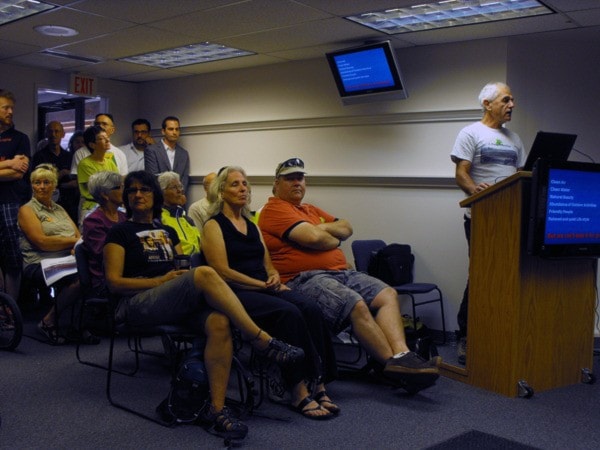With a room full of cycling supporters behind him, Ed Schum of the Comox Valley Cycling Coalition (CVCC) asked Courtenay council to build a bridge for pedestrians and cyclists across the Courtenay River this week.
In a presentation about sustainable transportation Tuesday, Schum spoke about the benefits of a bridge from the foot of Sixth Street near Central Builders over to Simms Millennium Park.
According to a survey by the CVCC in 2009, more than 70 per cent of the 653 respondents said they found conditions for cycling in the Valley dangerous. Almost all of them said they would ride their bikes more often if improvements were made, noted Schum.
"The message is loud and clear: we need safer bikeways to get more people to ride," he told council. "Most importantly, we need a safe crossing for pedestrians and cyclists over the Courtenay River because only the bravest dare to ride their bikes on the two existing bridges."
Schum explained that the proposed location from the foot of Sixth Street over to Simms Park is key to any cycling network in the Valley.
"Without it, we cannot expect a significant increase in people riding bikes for transportation," he said.
Schum showed a picture of the bridge over the Kicking Horse River in Golden, which was built in 2001 by the Timber Framers Guild (TFG) with the involvement of the full community.
The total cost of the bridge was $450,000, which is less than half of what it would have cost if it was done by a regular contractor, according to Schum.
"I cannot promise that we can do this for this price; our bridge is slightly longer, and Golden had all the timber and a lot of materials donated by businesses, so we have to see what we can do here," he said. "But, if the town of Golden with a population of less than 8,000 was able to do it, I would like to think that we can do it here in the Comox Valley."
Council received a letter from Randy Churchill of Courtenay, a director with the TFG, which was addressed to Schum and which expressed support for the initiative to see a covered timber frame bridge built to carry pedestrians and cyclists across the river.
The TFG partners with other non-profits or communities to take on special building projects that otherwise could not happen, according to Churchill's letter.
During his presentation, Schum told council about the population growth in the Comox Valley, noting there's an annual increase of about 1,600 people and thousands more cars.
"The ever-increasing number of cars in our streets is a serious threat to our lifestyle," he said. " It doesn't matter if we believe in the global problem of climate change or not, all one has to do is travel around our Valley and see the traffic congestion, hear the increased noise and smell the exhaust fumes to realize that this is not good for our health, our environment or our lifestyle."
Schum believes making it safer and easier for people to get on their bicycles can help combat some of these issues.
"It has proven in many cities all over the world that the bicycle can be the most cost-effective tool to help reduce traffic congestion, make our air cleaner and make our population healthier," he said. "Most, if not all, of these cities have found that investment into cycling gives the highest return on the transportation dollar."
The CVCC is asking council to recognize cycling as a "viable, healthy and environmentally friendly mode of transportation, as recommended in several studies and plans that have been adopted by council over the last 10 years or so," Schum told council.
As well, he said that investment for cycling should be considered to be investment for transportation, "not for a fun activity done by a special-interest group;" budgeting for transportation should favour projects that address the challenges the city is facing in transportation; and city staff should be directed to start implementing plans for improvements for cycling infrastructure, as recommended and prioritized by the Cycling Public Advisory Committee and the Comox Valley Cycling Task Force.
The CVCC strongly recommends that every effort is made to get the pedestrian/cycling bridge over the Courtenay River built in 2012.
"This project alone would give cycle commuting a tremendous boost in the whole region," said Schum. "Combined with a network of safe cycling routes throughout the Valley, it would encourage many people to use their bikes for transportation."
Coun. Jon Ambler commended Schum for his passion for advocating for safer cycling.
"I think it was Thomas Jefferson who said 'change doesn't come from satisfied people; change comes from dissatisfaction,' and you're dissatisfied with our status quo, and you've been an engine for change in a positive way, and I appreciate that," he said.
Bridges define cities, noted Ambler.
"In all the cities around the world, bridges are named; bridges are important for so many reasons," he said. "Covered bridges, when I lived in Eastern Canada, the wooden bridges people built were treasured artifacts; they weren't just part of the transportation infrastructure. So I think you have an excellent idea here."
writer@comoxvalleyrecord.com
